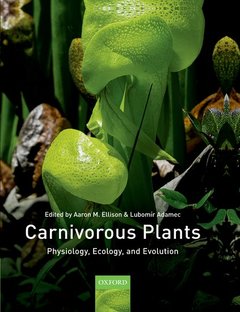Description
Carnivorous Plants
Physiology, Ecology, and Evolution
Coordinators: Ellison Aaron, Adamec Lubomír
Language: English
Subjects for Carnivorous Plants:
Carnivorous Plants
Publication date: 02-2019
552 p. · 19.2x24.8 cm · Paperback
Publication date: 02-2019
552 p. · 19.2x24.8 cm · Paperback
Carnivorous Plants
Publication date: 12-2017
548 p. · 19.6x25.2 cm · Hardback
Publication date: 12-2017
548 p. · 19.6x25.2 cm · Hardback
Description
/li>Biography
/li>
Carnivorous plants have fascinated botanists, evolutionary biologists, ecologists, physiologists, developmental biologists, anatomists, horticulturalists, and the general public for centuries. Charles Darwin was the first scientist to demonstrate experimentally that some plants could actually attract, kill, digest, and absorb nutrients from insect prey; his book Insectivorous Plants (1875) remains a widely-cited classic. Since then, many movies and plays, short stories, novels, coffee-table picture books, and popular books on the cultivation of carnivorous plants have been produced. However, all of these widely read products depend on accurate scientific information, and most of them have repeated and recycled data from just three comprehensive, but now long out of date, scientific monographs. The field has evolved and changed dramatically in the nearly 30 years since the last of these books was published, and thousands of scientific papers on carnivorous plants have appeared in the academic journal literature. In response, Ellison and Adamec have assembled the world's leading experts to provide a truly modern synthesis. They examine every aspect of physiology, biochemistry, genomics, ecology, and evolution of these remarkable plants, culminating in a description of the serious threats they now face from over-collection, poaching, habitat loss, and climatic change which directly threaten their habitats and continued persistence in them.
Aaron M. Ellison is the Senior Research Fellow in Ecology at Harvard University, and a semi-professional photographer and writer. He studies the disintegration and reassembly of ecosystems following natural and anthropogenic disturbances; thinks about the relationship between the Dao and the intermediate disturbance hypothesis and reflects on the critical and reactionary stance of Ecology relative to Modernism. Lubomír Adamec is the Senior Research Scientist in the Section of Plant Ecology of the Institute of Botany CAS at Trebon, Czech Republic, where he has been working since 1986. Since graduating in plant physiology from the Charles University in Prague, Czechoslovakia, he has been studying the ecophysiology of aquatic and wetland plants, especially carnivorous ones: mineral nutrition, photosynthesis, growth traits, Utricularia trap ecophysiology, and biophysics. He is the curator of the world's largest collection of aquatic carnivorous plants, currently including more than 80 species or populations, which is used extensively for research and plant conservation.
© 2024 LAVOISIER S.A.S.



